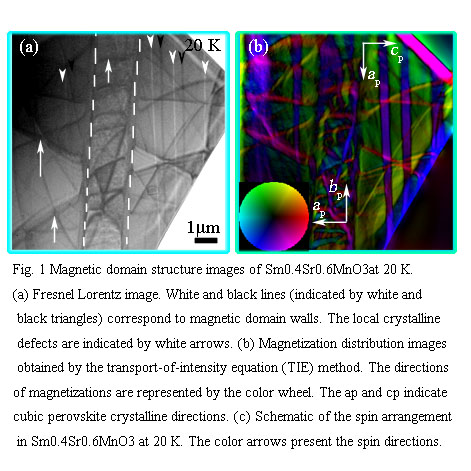[1] Colossal Magnetoreasistive Oxides, edited by Y. Tokura (Gorden and Breach Scirnce Publisher, 2000). [2] Y. Tomioka et al. Appl. Phys. Lett. 70 (26), 3609 (1997). [3] V. V. Volkov and Y. Zhu, Phys. Rev. Lett., 91 (2003) 043904.

Advanced Electron Microscopy Group, National Institute for Materials Science,* Correlated Electron Research Center, AIST, Japan** Spin Super Structure Project, ERATO, JST, Japan*** Advanced Electron Microscopy Group, NIMS, Japan**** Institute of Multidisciplinary Research for Advanced Materials, Tohoku Univ., Japan***** Department of Applied Physics, Univ. of Tokyo, Japan******
○Xiuzhen Yu* Yasuhide Tomioka** Yoshio Kaneko*** Toru Asaka**** Masahiro Nagao**** Weizhu Zhang**** Koji Kimoto**** Takahisa Arima***** Yoshinori Tokura****** Yoshio Matsui****
The doped perovskite manganite RE1-xAExMnO3 (RE: a rare earth element; AE: an alkaline element) has been attention to the colossal magnetoresistance properties [1, 2], which strongly correlate to the coupling among charge, orbital and spin. In order to study the magnetic properties for the canted C-type antiferromagnetic (AF) materials [1], such as RE0.4Sr0.6MnO3 (RE: Sm, Eu), magnetic domain structure was studied using the Lorentz TEM. Figure 1 shows the magnetic domain structure of Sm0.4Sr0.6MnO3 at 20 K. Fresnel image and transport-of-intensity equation [3] image reveal that the 180 degrees magnetic domains exist in the (010) thin crystal. The easy magnetization direction was found to be along the ap-axis (ap: the axis of cubic perovskite structure). Furthermore, it was found the local crystalline defects and twins of the sample decrease the magnetic domain size. This result is useful for understanding the magnetic property of the canted C-type AF manganites.
[1] Colossal Magnetoreasistive Oxides, edited by Y. Tokura (Gorden and Breach Scirnce Publisher, 2000). [2] Y. Tomioka et al. Appl. Phys. Lett. 70 (26), 3609 (1997). [3] V. V. Volkov and Y. Zhu, Phys. Rev. Lett., 91 (2003) 043904.
